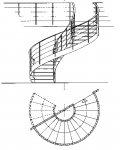James VanFossen
New member
- Joined
- Dec 26, 2009
- Messages
- 6
When building curved stairs a horizontal radius is used. But iif you want to cover the bottom of stairs you need the radius on the slope. I think there is a formula for this but don't know it. Can someone tell me what that is??? Thanks.






